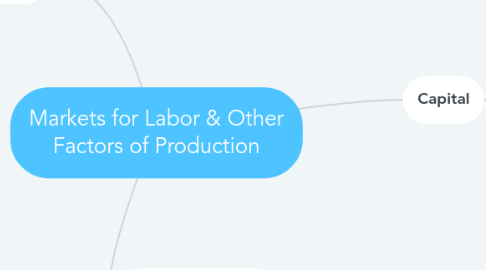
1. Labor
1.1. demand for labor
1.1.1. "derived" demand
1.1.1.1. labor demand depends on the demand for the good being produced
1.1.2. marginal product of labor
1.1.2.1. additional output as a result of hiring 1 more person
1.1.3. marginal revenue product of labor (MRP)
1.1.3.1. change in a firm's revenue as a result of hiring 1 more worker
1.1.3.2. decision making
1.1.3.2.1. if MRP > Wages, hire more workers
1.1.3.2.2. if MRP < Wages, hire less workers
1.1.3.2.3. if MRP = Wages, optimal # of workers
1.1.4. factors that shift the demand curve
1.1.4.1. changes in human capital
1.1.4.1.1. accumulated training & skills that workers possess
1.1.4.2. changes in technology
1.1.4.3. changes in price of the product
1.1.4.4. changes in quantity of other inputs
1.1.4.5. changes in # of firms in the market
1.2. supply of labor
1.2.1. when taking 1 hour leisure, we give up 1 hour of working
1.2.1.1. therefore, the wages are the opportunity cost of leisure.
1.2.2. factors that shift the market supply curve
1.2.2.1. increasing population
1.2.2.2. changing demographics
1.2.2.3. changing work opportunity alternatives
1.3. equilibrium
1.3.1. where labor demand = labor supply
1.3.2. shifts
1.3.2.1. if curve shifts right
1.3.2.1.1. wages decrease & labor increases
1.3.2.2. if curve shifts left
1.3.2.2.1. wages increase & labor decreases
1.4. explaining differences in wages
1.4.1. compensating differentials
1.4.1.1. higher wages to compensate workers for unpleasant aspects of job
1.4.1.2. Ex: 3rd shift pays more than 1st shift
1.4.2. discrimination
1.4.2.1. difference in education
1.4.2.2. difference in experience
1.4.2.3. differing preference for jobs
1.4.2.4. labor unions
1.5. personnel economics
1.5.1. application of economic analysis to human resources issues
1.5.1.1. wage systems
1.5.1.1.1. straight-time
1.5.1.1.2. commission
1.5.1.1.3. piece-rate
2. Natural Resources
2.1. marginal revenue product of natural resources
2.1.1. the change in a firm's revenue as a result of employing 1 more unit of natural resources
2.2. economic rent
2.2.1. the income derived from the ownership of land and other free gifts of nature
2.3. Monopsony
2.3.1. situation where a firm is the only buyer of a factor of production
3. Capital
3.1. rented machines, equipment, buildings
3.2. marginal revenue product of capital
3.2.1. the change in the firm's revenue as a result of employing 1 more unit of capital
